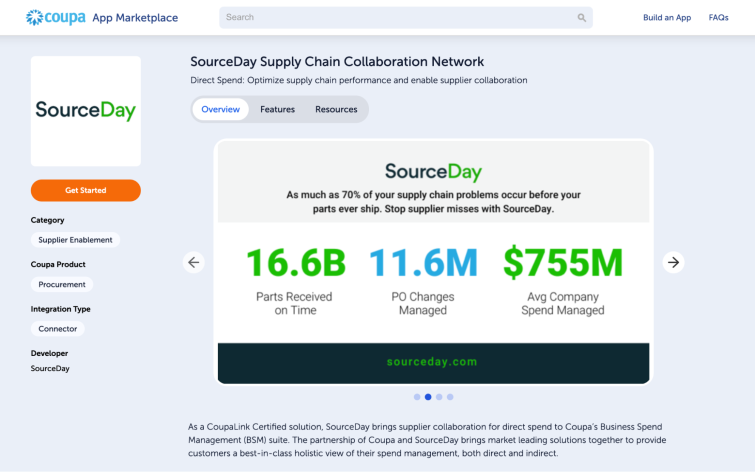Supply Chain Strategies for the New Abnormal: How to Survive (and Thrive) with Coupa and SourceDay

Today's post is co-written by Dr. Madhav Durbha, VP of Supply Chain Strategy at Coupa, and guest author Dr. Adeel Najmi, Chief Product Officer at SourceDay. SourceDay is a CoupaLink technology partner that provides advanced supplier collaboration so customers get a holistic view of their spend, both direct and indirect.
Despite recent movement in the right direction, supply chain challenges remain. According to a new Harvard Business Review Analytic Services briefing paper, “organizations are learning the hard lesson that to build resilience in today’s environment, they need to improve supply chain flexibility and agility through greater visibility into the risk and vulnerabilities they face throughout the supply and distribution ecosystem.”
The hard truth? Supply chain strategies have permanently changed. While reliability is on the right track and costs are coming down, the long-tail impact of COVID means that companies must be prepared to deal with supply chains as they are now and what they may become — not what they used to be.
Here's what you need to know about the current state of supply chains, different supply chain strategies to navigate this “new abnormal,” and how Coupa and SourceDay can level up supply chain performance.
The current state of supply chain
The last two years came with significant supply chain upheavals. Now, three factors play a key role in the current state of supply chains.
Long-term volatility
As demand for goods and components skyrocketed during the early days of COVID, companies and suppliers made the only choice they could: invest in multiple partners to smooth out the bumps in the road. Now, however, many companies find themselves facing over- rather than under-stock situations as demand has tapered off and delivery times have evened out.
This is the bullwhip effect: changes made at the beginning of and during the pandemic are causing larger issues in supply chains the farther out they travel from the initial crack of the whip. As a result, volatility remains.
Past/future disconnects
In 2019, no one could have predicted the impact of 2020. The same holds for 2020 to 2021, into 2022, and so on. Where companies were once able to rely on historical supply chain data to suggest emerging patterns, the past is no longer a reliable predictor of the future, which means forward visibility is key.
Exposure of manual touchpoints
Remote operations during COVID exposed the impact of manual and paper touchpoints in business operations. This caused delays in sensing demand and supply changes, led to over-reliance on in-office clerical staff, introduced unnecessary complexity, and resulted in data entry errors. All of these issues increased information latency and reduced the efficacy of supply chain operations, which cost companies money.
The result was a forced shift to digitalization that required companies to adapt quickly or risk going under. Now, digital operations are par for the course in any supply chain interaction.
More supply chain strategies to help you thrive
A return to supply chain "normal" isn't on the horizon. Instead, companies must explore different supply chain strategies to navigate the “new abnormal" state of operations — now and into the future. Here are a few key examples of supply chain strategies that your company can explore.
Create continual agility through technology
Supply and demand must be continually realigned across trading and logistics partners despite ongoing changes. This is where technology can change the game. For example, digital twins create a continually updated view of what's happening in the real world so supply chain leaders can use this data to update and improve internal operations.

The requisite agility for the extended supply chain is simply impossible with traditional inside-out enterprise systems, one-sided portals, emails, and spreadsheets. Now, a new generation of multi-enterprise cloud SaaS networks are enabling trading partners to share forward visibility, prioritize exceptions, collaborate in real time, and stay continually aligned to execute in lock-step despite changes on both sides.
As one example, one company that underwent such a transformation told us how they worked with their suppliers in China during the pandemic. They used hot-lists to clearly identify the parts that were most critical any given day. In addition, they actively used a concept we call “radar” that bumps up tasks that must be completed soon. They managed to survive the pandemic with zero factory downtime, unlike many of their peers.
Balance cost and risk
With the economic recession upon us, companies must find a way to balance cost and risk. While the tendency is to slip back into cost-cutting patterns, it's critical to find a balance that eliminates single points of failure but still provides room for companies to evolve as supply chains change.
On one hand, companies must recognize that delays in sensing demand or supply changes directly translate to cost overages through excess inventories. On the other, they have lost demand from stockouts paired with high expedite costs. It’s these types of cost and risk trade-offs that supply chain partners must be able to evaluate through data-driven models so they can build digital collaboration capabilities for resilient execution.
If there is a silver lining from the supply chain challenges of the past few years, it is that companies have indeed changed their perspective on this matter. In conversations before the pandemic, one procurement leader gave very compelling reasons why his company relied on single sources due to having very specialized and high-grade part requirements. They had built deep relationships with key suppliers, so it did not make sense for them to diversify. Early in 2022, however, that same leader told us the company had changed its posture and had begun qualifying second sources for key components, despite the higher cost. Notably, the procurement leader also kickstarted innovation initiatives to set up easier digital collaboration with suppliers.
Evaluate provider portfolios
The right partner can make all the difference in navigating the new abnormal. As a result, it's worth conducting an in-depth assessment of provider portfolios to find key partners that can meet supply chain goals of material availability, cost, responsiveness, quality, and ESG compliance. By developing deep relationships with these partners, companies can set themselves up for success.
Establish metrics for mutual accountability
To ensure both businesses and their suppliers are held accountable in the new supply chain, metrics are key. First, companies need to pinpoint critical KPIs, such as metrics on responsiveness, on-time delivery, and accuracy of committed forecasts or delivery promises. Once they’ve agreed on these metrics, the companies can then deploy collaboration network solutions capable of measuring and monitoring this data, providing mutual transparency and accountability from both sides.
Cultivate collaboration
Multi-level collaboration starts with strategic product sourcing collaboration, moves to the tactical collaboration of sharing forecasts, and now includes transactional collaboration that provides a mutually verified view of inbound and outbound supply, along with three- and four-way purchase order (PO) matching. Such end-to-end transactional collaboration enables visibility both parties can trust.
This starts with the supplier having real-time visibility to the latest purchase requests, including changes. Importantly, the supplier must acknowledge the purchase request and confirm the price, quantities, and dates. One customer recently told us, “If a PO has not been acknowledged, then the material won’t be here on time — 100% of the time!”
Still, unforeseen events can cause subsequent changes to POs, even after suppliers confirm the details. Strong collaboration networks enable a direct line of communication between the buyer and supplier in the context of every order and every order line. This way, business priorities are considered during day-to-day decisions. Direct visibility into shipments via ready-to-ship or advance ship notifications is also a key in cultivating better collaboration.
Finally, it’s vital to connect the dots between PO lines, receipts, accepted quantities, and invoices so that all parties have shared and complete visibility of the purchase order — from planned order to completed delivery. This leads to a much more accurate view of inbound supply visibility that has been mutually verified and aligned every step of the way.
As you explore ways to put these supply chain strategies into practice, it’s important to have the right technology in place.
How Coupa and SourceDay level up supply chain performance
With Coupa and SourceDay, companies can get the best of both worlds when it comes to supply chain management.

Using Coupa's Business Spend Management (BSM) platform, companies can gain a comprehensive view of BSM operations and design their supply chain to find the right balance between cost and risk.
Meanwhile, by integrating SourceDay, businesses can connect directly with suppliers to collaborate on direct material purchase orders, establish lines of shared visibility, minimize supply chain disruptions, and maintain mutual accountability from end to end. Companies using SourceDay have reported over 70% reduction in late orders and over 35% increase in on-time in-full deliveries.
Start With SourceDay on the Coupa App Marketplace
